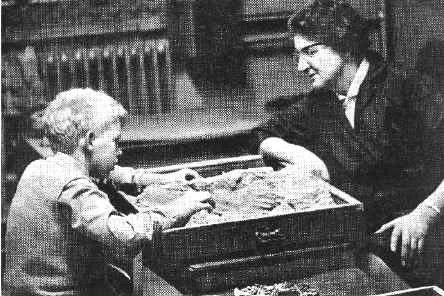TOYS FOR READING A CHILD’S MIND
Lowenfeld Worker with a patient, 1936
This historical pamphlet is reproduced to give a sense of the Institute of Child Psychology's beginnings and the way in which the child's sandplay work was understood by the therapist of the time.
For an hour Michael’s conversation consisted solely of "hrrow" and "frumph" except for the one occasion when he asked for more wet sand to make the hill bigger. A slenderly sturdy 12-year-old with eyes and hair almost as ashen as those of an albino, he remained so intently absorbed in his game with the sand tray as to seem unaware even of the low-voiced commentary of the psychotherapist who never left his side.
At first he sat quietly arranging opposing toy armies on either side of the hummock of sand with which he had divided the lead-lined tray across its width. Halfheartedly he set an infantryman to tunnel through the base of the mound, only to be shot by the cavalryman who came charging over the top from the other side; a large chunk of wet sand crumbled from the hill during the engagement. Michael hesitated fractionally—then flattened the whole landscape with a sweeping blow of his fist. He discarded the toy soldiers, rebuilt the hill higher and firmer; then demolished it again with a clenched fist.
More wet sand, and another bigger, better hill. This one scattered dramatically at the impact of a fist backed up by the short run from the window to the table. Again and again the hill was built, then destroyed with increasing violence. Neither the thumps and shouts of an indoor football game in the room across the corridor, which is specially equipped for movement and noise, nor the intermittent comments of the psychotherapist caused his concentration to flicker for an instant.
The football game finished and John and Jim spilled into the playroom. A few minutes’ excited conversation about the score, then each settled down with his own psychotherapist, John to build a sand picture of cowboys attacking an Indian encampment in a dense toy forest, Jim to assemble a primitive truck. The three boys ignored each other. They were working, in a world specially designed for children to work in their own way, from which all adults except green-overalled psychotherapists are excluded.
In the six rooms and enclosed garden which form the children’s sanctum at the Institute of Child Psychology in Bayswater, London, almost anything goes. There are no rules or restrictions for the children, except the occasional restraint needed to prevent a particularly exuberant child damaging himself or another child or wrecking the furniture. For the adults observing the children at work one paramount rule is their guide: the standards of behaviour in the playrooms are the standards of children and not of adults. So every adult in the playroom is nearly always entirely at the disposal of the child, carrying out orders without question, criticism, or reproof, laying no blame and making no adverse comment even when the child’s use of toys or materials seems misdirected.
But the children are under no misapprehension but that they are there to work. From the beginning each child is told that whatever he does in the playroom has a meaning: no matter what form of activity he chooses—and the choice is the child’s—he is expressing some thought or emotion, and together the child and the therapist will try to work out the significance of his play. For these children are in trouble, and most of them know it. Though none of them is mentally subnormal, they are just as seriously crippled by emotional disturbances, behaviour difficulties—including delinquency—educational difficulties, personal anxieties, phobias, and withdrawals, and some of the physical complaints such as asthma or intestinal troubles that are often aggravated by emotional upsets.
School troubles
Michael, for instance, is known to his parents as a docile, submissive child; at school he is an intolerable bully; and he suffers from chronic constipation, born of a fear of going to the lavatory. John is a highly intelligent, charming, and strikingly handsome coloured boy who delights in creating havoc at school—another of an increasing number of immigrant children trying to cope with a double social standard. Jim, fine-boned and sensitive, is rejected by his mother because of his strong physical likeness to his dead father; a bright child, he lacks concentration at school, and attacks his mother and rips up the furniture at home. Each of these children is gripped by feelings and ideas he doesn’t like but cannot understand, is helpless to rectify but cannot accept, and is powerless to rationalize verbally as an adult would.
It was the theory that young children have a form of non-verbal thinking before they have a grasp of language for communication which prompted Dr Margaret Lowenfeld, in 1928, to found the Institute of Child Psychology. Aiming to treat disturbed children whose parents could not afford specialist fees, she collected play materials from all over the world and let the children loose among them. It gradually became evident that given a "vocabulary" of materials through which they can "talk", children in spontaneous play will express their ideas and feelings about the world, working out and trying to come to terms with their experiences. So by close observation of the play of disturbed children it is possible to track down conceptions and misconceptions which were formed at a time when experience was a diffuse mass of sensory feelings and emotional reactions with a small child trying to understand them.

